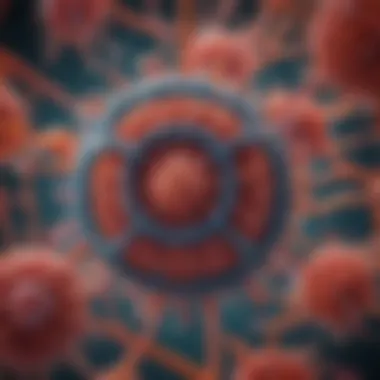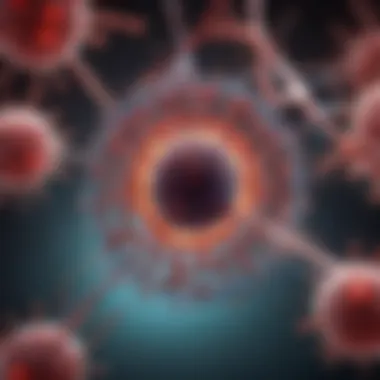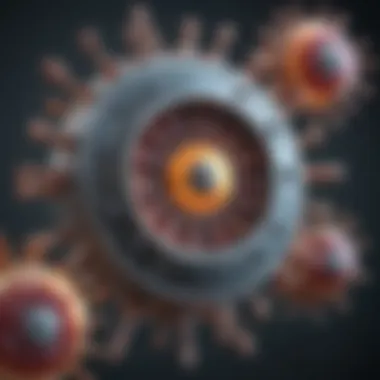Understanding Retroviruses: Insights from Addgene


Overview of Research Topic
Brief Background and Context
Retroviruses are a unique class of RNA viruses capable of transcribing their RNA genome into DNA, a process that fundamentally changes our understanding of gene expression and genetic modification. The earliest identified retrovirus, Rous sarcoma virus, shed light on the transformative potential of these entities in both pathology and therapeutic applications. Over decades, the interest in retroviruses has grown, particularly in their role as tools for gene therapy and molecular biology research.
The process of gene delivery using retroviruses is now a significant area explored by researchers. Addgene, a nonprofit plasmid repository, has made substantial contributions to this field, facilitating the sharing of key resources that assist scientists in harnessing the power of retroviral vectors. By providing plasmids and other resources, Addgene plays a central role in making genetic research more accessible and efficient.
Importance in Current Scientific Landscape
The ability of retroviruses to integrate into host genomes allows for long-term expression of desired genes, which is vital for both therapeutic and research purposes. In the current scientific landscape, the implications are profound. Retroviruses are used in various applications, from gene therapy for inherited diseases to the study of gene function in different organisms.
Safety considerations and ethical issues, however, remain relevant topics of discussion. As researchers navigate the potential benefits and risks associated with retroviral use, the need for informed practices becomes clear. Understanding these aspects is essential for anyone involved in genetic research.
Methodology
Research Design and Approach
This article employs a comprehensive analysis of existing literature alongside insights from Addgene's resources. The focus is on elucidating the structure and function of retroviruses, assessing their role in gene delivery, and analyzing technological advancements that influence their application in research.
Data Collection Techniques
Data for this discussion is collected from scientific journals and published papers related to retroviruses. Furthermore, Addgene's database serves as a vital source for recent developments and practical applications. Information from reputable platforms like Wikipedia, Britannica, and forums like Reddit enrich the analysis, providing diverse perspectives on retrovirus research.
"Retroviruses have emerged as invaluable tools for genetic engineering, offering novel pathways to advance therapies and research methodologies."
Through a detailed examination of the role played by Addgene in the retrovirus landscape, this article aims to articulate a thorough understanding of the topic.
In the following sections, we will delve deeper into the structural aspects of retroviruses, their mechanisms of action, safety protocols, and ethical considerations, culminating in a clearer picture of their potential and limitations in modern genetic research.
Prologue to Retroviruses
Retroviruses are a distinct group of viruses that play a crucial role in the field of molecular biology and genetics. Their unique properties allow them to integrate their genetic material into the host genome, making them invaluable tools for researchers and clinicians alike. Understanding retroviruses provides insight into gene delivery mechanisms and their application in gene therapy, which can potentially revolutionize treatments for various genetic disorders.
The importance of this topic extends far beyond just academic curiosity. Retroviruses have practical implications in the development of vaccines and therapeutic strategies. By exploring their functions and characteristics, researchers can harness their capabilities for innovative applications.
Definition and Characteristics
Retroviruses are enveloped viruses that contain an RNA genome. When infecting a host cell, they undergo a process called reverse transcription, converting their RNA into DNA. This new DNA can then integrate into the host's genome, allowing the viral information to be copied and passed on to daughter cells during cell division.
Key characteristics of retroviruses include:
- Enveloped Structure: They possess a lipid bilayer that encases the viral capsid, aiding in cellular entry.
- Single-Stranded RNA: Unlike many other viruses, retroviruses carry single-stranded RNA as their genetic material.
- Reverse Transcriptase: A critical enzyme that enables the conversion of RNA into DNA, facilitating integration into the host genome.
This combination of features makes retroviruses particularly well-suited for research and therapeutic applications. Their ability to integrate into the host genome can lead to long-term expression of inserted therapeutic genes.
History and Discovery
The history of retroviruses spans several decades, beginning with their discovery in the realm of cancer research. In the 1900s, scientists noted a connection between certain viruses and the development of tumors in animals. This led to the identification of the first retrovirus, Rous sarcoma virus, in 1911.
Further research into retroviruses revealed their association with various diseases, including HIV/AIDS. The discovery of HIV as a retrovirus further emphasized the importance of understanding these pathogens in the context of public health. Through advancements in molecular biology, researchers have developed various techniques to study retroviruses, expanding our knowledge about their mechanisms and applications.


Recent developments in the field continue to transform our understanding of retroviruses, fostering discussions about their potential in gene therapy and medical treatments. As research progresses, the significance of retroviruses will likely grow, influencing both scientific and medical landscapes.
Molecular Biology of Retroviruses
The significance of the molecular biology of retroviruses lies not just in understanding these unique pathogens but also in their broad applications in genetic research. Retroviruses, known for their ability to integrate into the host genome, provide insight into fundamental biological processes. They offer researchers tools for gene delivery, gene therapy, and the creation of transgenic models. These applications have broad implications, paving the ground for advancements in medicine and biotechnology.
Structure of Retroviral Particles
Retroviral particles have a distinctive structure characterized by an outer lipid envelope derived from the host cell membrane. This envelope surrounds the core, which contains the viral RNA and essential enzymes. The detailed architecture allows retroviruses to elegantly perform their function of infection and replication. The size and shape of these particles can vary, yet they generally form spherical structures that assist in their survival and transmission.
Life Cycle of Retroviruses
The life cycle of retroviruses is a complex progression that entails several critical steps, each contributing significantly to their ability to infect host cells.
Attachment
Attachment is the initial interaction between the retrovirus and host cell. Retroviruses have surface proteins that recognize and bind to specific receptors on the host cell. This specificity is crucial because it determines the tropism of the virus, meaning which cells it can infect. This aspect of attachment enhances the effectiveness of retroviruses as vectors in gene therapy since targeting specific cells is essential for successful treatment.
Entry
Entry involves the fusion of the viral envelope with the host cell membrane. Upon successful binding, the retrovirus undergoes conformational changes that facilitate this fusion, allowing the viral core to enter the cell. This process is vital as it marks the beginning of viral replication. The unique feature of entry through direct membrane fusion also means it can bypass specific cellular defense mechanisms, making retroviruses particularly effective.
Reverse Transcription
Reverse transcription is a crucial step where the viral RNA is converted into DNA. The enzyme reverse transcriptase catalyzes this process. This unique feature allows retroviruses to integrate their genetic material into the host genome, leading to stable inheritance of viral genes. It is beneficial to gene therapy since the integrated DNA can persist in the host, potentially allowing for long-term therapeutic effects.
Integration
Integration is where the newly formed viral DNA integrates into the host's genomic DNA with the help of integrase. This ensures that the viral genome can be replicated during cell division. The integrated retroviral DNA, also known as a provirus, can be expressed alongside the host genes. This aspect is critical as it provides a mechanism for stable gene expression, a vital consideration for therapeutic applications involving gene therapy.
Replication and Assembly
Replication and assembly involve the host cell machinery transcribing and translating the integrated viral DNA to produce new viral components. These components are subsequently assembled into new viral particles. This step is important because it enables the production of multiple new viruses from a single infection event, further propagating the retrovirus and its genetic material.
Key Enzymes Involved
Several key enzymes play pivotal roles in retroviral biology, influencing their lifecycle and functionality.
Reverse Transcriptase
Reverse transcriptase is essential for converting viral RNA to DNA. Its efficiency makes it a fundamental target in antiretroviral therapies. The capability to synthesize DNA from RNA unlocks opportunities for therapeutic strategies, although its error-prone nature can lead to mutations, posing challenges for treatment durability.
Integrase
Integrase facilitates the incorporation of viral DNA into the host genome. This step is crucial for viral persistence. Integration is utilized in genetic engineering, making integrase an attractive target for inhibitors in efforts to combat retroviral infections. Its specificity for viral DNA means potential interventions can be developed to selectively prevent retroviral proliferation.
Protease
Protease is responsible for cleaving viral polyproteins into functional proteins, a necessary step for forming mature viral particles. Its role in viral maturation makes it a target for many antiviral drugs. Interfering with protease function inhibits viral replication, highlighting its importance in therapeutic development.
By delving into the molecular biology of retroviruses, including their structures, life cycles, and key enzymes, we can appreciate the sophisticated mechanisms that govern their interactions with hosts. This understanding is fundamental for leveraging retroviruses in research and therapeutic applications.


Retroviral Applications in Research
Understanding the role of retroviruses in research is critical. Retroviruses serve as powerful tools in genetic manipulation and molecular biology. Their unique ability to integrate into the host genome makes them invaluable for various applications, such as gene therapy, transgenic models, and RNA interference. The exploration of these areas opens doors to innovative solutions in the treatment of diseases and in understanding complex genetic mechanisms.
Gene Therapy Approaches
Gene therapy using retroviruses aims to treat or even cure diseases by delivering healthy genes into a patient’s cells. One significant advantage of retroviral gene therapy is the potential for stable integration of the therapeutic genes. For instance, vectors like the Moloney murine leukemia virus (MLV) are commonly used to carry genes into human cells. This method not only allows long-term expression of the introduced gene but also offers a way to address genetic disorders at their source.
However, there are important considerations. The insertion of new genetic material can lead to unintended consequences, including insertional mutagenesis. This is a risk where the integration of the vector disrupts existing genes, potentially leading to oncogenesis. Therefore, careful design and selection of retroviral vectors are crucial to minimize these risks while maximizing therapeutic efficacy.
Transgenic Models
Transgenic animal models are another significant application of retroviruses in research. By integrating specific genes into the genome of an organism, researchers can study the effects of those genes in vivo. Retroviruses, particularly the lentiviral vectors, are favored due to their efficiency in delivering genetic material across various cell types. These models allow for the investigation of gene function and the development of treatments for diseases like cancer and neurological disorders.
Creating these models involves careful engineering of retroviral vectors to ensure that the transgenes are expressed appropriately. For example, the choice of promoter driving the transgene expression can significantly impact the outcome. Overall, transgenic models provide a robust framework for understanding gene function and disease mechanisms.
RNA Interference and Gene Silencing
RNA interference (RNAi) represents a powerful approach for gene silencing, and retroviruses play a substantial role in delivering small interfering RNAs (siRNAs) into target cells. By doing so, researchers can selectively inhibit the expression of specific genes, offering valuable insights into gene function and potential therapeutic angles for various diseases.
Using retroviral vectors for RNAi facilitates stable expression of siRNAs, enabling prolonged silencing effects compared to transient methods. This stability enhances the feasibility of long-term experiments and therapeutic applications. For instance, the introduction of siRNA against a specific viral target can suppress viral replication, which is particularly relevant in viral research and therapy.
Yet, challenges remain. Delivering siRNAs specifically to the desired cells without off-target effects is crucial. Development of targeting ligands and advanced vector design can help solve this issue.
"The use of retroviruses in RNA interference not only advances our understanding but also has potential applications in developing treatments for challenging diseases."
In summary, retroviral applications in research span diverse and significant avenues, each contributing to the broader understanding of genetics and disease. By leveraging these approaches, researchers can develop innovative solutions that could transform treatment paradigms in medicine. For thorough resources, consider checking Addgene's collection on gene therapy and other relevant materials available through Wikipedia and Britannica.
Addgene's Role in Retroviral Research
Addgene plays a crucial role in retroviral research by providing significant resources and facilitating collaboration among researchers. This section explores how Addgene enhances the opportunities for scientific inquiry and ensures a reliable supply of vital materials. Understanding Addgene's contributions is essential for appreciating the broader impact of retroviral work on genetic research.
Overview of Addgene
Addgene is a nonprofit organization that specializes in sharing plasmids and other genetic tools. Founded in 2004, it has become an invaluable resource for scientists worldwide. Its mission is to make the sharing of biological materials more efficient and accessible. By providing a centralized platform for researchers to deposit and request plasmids, Addgene reduces barriers to entry in genetic research. This openness fosters innovation and collaboration across the scientific landscape.
Resource Availability for Researchers
Plasmids and Vectors
Plasmids and vectors are fundamental tools in the field of molecular biology. Addgene offers a diverse collection of these materials, making them easily accessible for researchers. One key characteristic of plasmids is their ability to replicate independently within host cells, allowing for the amplification of desired genes. This feature makes plasmids a popular choice for gene delivery and expression studies.
Moreover, Addgene’s database includes plasmids that target various applications, such as gene therapy and the creation of transgenic models. A unique aspect of Addgene's offerings is the detailed information about each plasmid provided in its catalog. This includes the sequence information, associated publications, and validation data. This transparency allows researchers to confidently select tools that fit their specific research needs, thus encouraging the efficient progress of studies.
Protocols and Video Tutorials
Protocols and video tutorials are essential for guiding researchers in the effective use of plasmids and vectors. Addgene provides a wide range of detailed protocols that cover various experimental techniques involving retroviruses. These resources contribute to the goal of reducing experimental error and improving reproducibility in research.
Each protocol is meticulously prepared to ensure clarity, which is a significant advantage for both inexperienced and seasoned researchers. Additionally, Addgene’s video tutorials offer visual guidance, making complex techniques easier to understand. However, while these resources enhance learning, researchers must still apply critical thinking and personal experience to adapt protocols to their specific situations.
Community and Collaboration Opportunities


Addgene fosters a vibrant community of researchers interested in retroviral research. By providing platforms for interaction, it encourages collaboration among scientists from various backgrounds and expertise levels. Online forums and social media channels facilitate discussions on best practices, experimental designs, and troubleshooting. This collaborative environment is vital for advancing knowledge and innovation in the field of retrovirology.
Safety and Ethical Considerations
The examination of safety and ethical considerations within retroviral research is crucial. Retroviruses have various applications that extend from gene therapy to influencing cancer treatment. However, the manipulation of these viruses also opens a discussion on potential risks and moral implications. Addressing these aspects is essential to foster responsible research.
Biosafety Levels in Retroviral Work
Biosafety levels (BSL) are a series of guidelines established to protect laboratory personnel, the environment, and the community from harm. Retroviruses are typically handled under BSL-2 or higher, depending on the nature of the work being conducted.
- BSL-2: This level applies when working with agents that pose moderate hazards. Common practices include wearing lab coats, gloves, and face protection. Facilities need to have biohazard warning signs and equipment to limit exposure.
- BSL-3: This level is required for work involving pathogens that can be transmitted through the air. Facilities must have ventilated cabinets and controlled access to prevent unintentional exposure.
Understanding these levels helps researchers mitigate risks effectively. Institutions also have committees that evaluate experimental protocols to ensure that appropriate safety measures are in place for handling retroviruses.
Regulatory Frameworks and Guidelines
Various regulations govern the use of retroviruses in research and therapy. These policies ensure that safety is prioritized and guide researchers in ethical practices. Key regulatory bodies include:
- U.S. Food and Drug Administration (FDA): Oversees the approval of retroviral therapies and gene therapies, ensuring they meet safety and efficacy standards.
- Centers for Disease Control and Prevention (CDC): Provides guidelines for laboratory safety in handling infectious agents, including retroviruses.
- Institutional Biosafety Committees (IBC): Require that researchers conduct risk assessments and obtain approvals before commencing projects involving recombinant DNA and retroviruses.
Adhering to these frameworks is essential for advancing research while minimizing risk to human health and the environment.
Ethical Implications in Gene Editing
Gene editing, particularly using retroviral vectors, raises several ethical questions. The implications can be profound, and thoughtful consideration is necessary.
- Informed Consent: Researchers must ensure that participants in gene therapy trials are fully informed about the risks and benefits. Clarity around the process, potential side effects, and long-term consequences is vital.
- Access and Equity: As gene therapies advance, issues of accessibility arise. Ensuring that these treatments are available to diverse populations is an ethical concern.
- Potential for Misuse: There is a risk that technologies associated with retroviruses could be misused for non-therapeutic enhancements. This leads to societal debates on defining acceptable limits for genetic modifications.
The ethical landscape of gene editing is complex and requires ongoing dialogue among stakeholders to navigate responsibly.
Overall, acknowledging and addressing safety and ethical considerations in retroviral research helps lead to responsible scientific advancement while protecting both researchers and the community.
Future Directions in Retroviral Research
The exploration of retroviruses is an ongoing journey. As technology and methodologies advance, researchers can uncover new potentials held by these viruses. This section will discuss how innovations, applications, and partnerships with biotechnology firms can shape the future of retroviral research. Understanding these directions is crucial for students, educators, and professionals alike, as it informs not only the science itself but also its implications on society and medicine.
Innovations in Vector Development
Innovative approaches in vector development are central to enhancing the performance of retroviruses as delivery vehicles for genetic material. Modern advancements focus on improving efficiency, targeting capabilities, and minimizing risks associated with off-target effects. Key innovations include:
- Self-Inactivating Vectors: These vectors are designed to prevent replication and mitigate risks of insertional mutagenesis, thus increasing safety profiles.
- Modular Vector Systems: These systems allow customization of vectors for specific applications, improving versatility in research and therapeutic contexts.
- Modified Envelope Proteins: Adjusting envelope proteins improves tissue specificity, thereby enhancing the delivery of therapeutic genes to intended cells more effectively.
Such innovations are not just incremental; they could fundamentally change how gene therapy is conducted, expanding the reach and effectiveness of retroviral vectors in clinical settings.
New Applications and Discoveries
The realm of retroviruses is fertile for novel applications. As our understanding deepens, new uses for retroviruses are being discovered. Some notable possibilities include:
- CRISPR-Cas9 Gene Editing: Retroviruses can be harnessed to deliver CRISPR components, significantly improving gene editing precision and delivery efficiency.
- Personalized Medicine: By harnessing retroviruses, researchers can create tailored therapies that address the unique genetic makeup of individual patients, particularly in cancer treatment.
- Vaccine Development: Retroviral vectors show promise in delivering antigens for vaccines, as demonstrated in some experimental approaches against various viral diseases.
These applications not only broaden the field of retroviral research but also have the potential to revolutionize how genetic conditions and diseases are treated, making them highly relevant for future studies and applications.
Collaboration with Biotechnology Firms
Collaboration between academic institutions and biotechnology firms can significantly enhance research outcomes. Such partnerships allow for the exchange of knowledge, resources, and expertise. Key aspects of these collaborations include:
- Resource Sharing: Biotechnology companies often have access to advanced technologies and tools that academic researchers can leverage.
- Funding Opportunities: Collaborations can open doors for additional funding, facilitating expansive research projects that might not be feasible independently.
- Commercialization of Research: Working closely with industry can accelerate the process of bringing research findings from the lab to real-world applications.
Collaboration is key. The synergy of theoretical knowledge from academia and practical expertise from industry is essential for pushing the boundaries of retroviral research.



